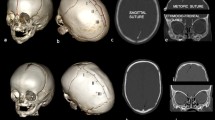Abstract
Purpose
To present a modified cranial vault asymmetry index, evaluate it by measuring the asymmetry of the skull shape with craniosynostosis and by assessing the surgical outcome quantitatively, compare it with traditional cranial vault asymmetry index (CVAI) and discuss its advantages and shortcomings.
Methods
Based on the traditional CVAI, anterior cranial vault asymmetry index (ACVAI) and posterior cranial vault asymmetry index (PCVAI) were proposed to evaluate surgical outcomes. We measured CVAI, ACVAI and PCVAI on the reconstructed three-dimensional computed tomography images to analyze the degree of the malformation and assess the surgical outcomes. The new method was compared with the traditional one, and statistical analysis was performed.
Results
Using Wilcoxon Rank Sum Test, preoperative ACVAI compared to postoperative one is statistically significant (p = 0.018), whereas, the p value for CVAI is 0.128 > 0.05.
Conclusions
The ACVAI and PCVAI as modified can better describe the degree of cranial vault asymmetry compared with CVAI. It is also a more reliable index to assess the surgical outcomes quantitatively.





Similar content being viewed by others
References
Agrawal D, Steinbok P, Cochrane DD (2006) Diagnosis of isolated sagittal synostosis: are radiographic studies necessary? Childs Nerv Syst 22:375–378
Boyle CM, Rosenblum JD (1997) Three-dimensional CT for pre- and postsurgical imaging of patients with craniosynostosis: correlation of operative procedure and radiologic imaging. AJR Am J Roentgenol 169:1173–1177
Branson HM, Shroff MM (2011) Craniosynostosis and 3-dimensional computed tomography. Semin Ultrasound CT MR 32:569–577. doi:10.1053/j.sult.2011.07.002
da Silva Freitas R, de Freitas Azzolini T, Shin JH, Persing JA (2010) Associated (parallel) tomographic findings in patients with single-sutural synostosis. J Craniofac Surg 21:411–413. doi:10.1097/SCS.0b013e3181cfa7ad
Fearon JA, Singh DJ, Beals SP, Yu JC (2007) The diagnosis and treatment of single-sutural synostoses: are computed tomographic scans necessary? Plast Reconstr Surg 120:1327–1331
Garza RM, Khosla RK (2012) Nonsyndromic craniosynostosis. Semin Plast Surg 26:53–63. doi:10.1055/s-0032-1320063
Hall P, Adami HO, Trichopoulos D, Pedersen NL, Lagiou P, Ekbom A, Ingvar M, Lundell M, Granath F (2004) Effect of low doses of ionising radiation in infancy on cognitive function in adulthood: Swedish population based cohort study. BMJ 328(7430):19
Kabbani H, Raghuveer TS (2004) Craniosynostosis. Am Fam Physician 69:2863–2870
Loveday BP, de Chalain TB (2001) Active counter positioning or orthotic device to treat positional plagiocephaly? J Craniofac Surg 12:308–313
Posnick JC, Bite U, Nakano P, Davis J, Armstrong D (1992) Indirect intracranial volume measurements using CT scans: clinical applications for craniosynostosis. Plast Reconstr Surg 89:34–45
Seibert JA (2004) Tradeoffs between image quality and dose. Pediatr Radiol 34(Suppl 3):S183–S195 (discussion S234–41)
Conflict of interest
No author has any financial support and potential conflicts of interest for this work. The work described has not been submitted elsewhere for publication, in whole or in part, and all the authors listed have approved the manuscript that is enclosed.
Ethical standards
The experiments comply with the current laws of China in which they were performed. The data collection for this paper was approved and carried out under the recommendations of the PUMC Plastic Surgery Hospital IRB.
Author information
Authors and Affiliations
Corresponding author
Rights and permissions
About this article
Cite this article
Yin, H., Dong, X. & Yang, B. A new three-dimensional measurement in evaluating the cranial asymmetry caused by craniosynostosis. Surg Radiol Anat 37, 989–995 (2015). https://doi.org/10.1007/s00276-015-1430-y
Received:
Accepted:
Published:
Issue Date:
DOI: https://doi.org/10.1007/s00276-015-1430-y




